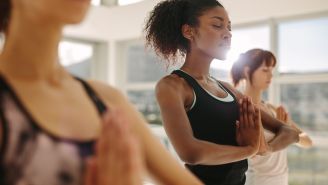Updated on October 22, 2024.
One of the hardest things about exercise isn’t that it takes effort or makes you sweaty. It’s that it’s often so difficult to know whether you’re making the right moves to get into shape. After all, the human body has well over 600 muscles. How can you possibly tone them all in the little time you have?
Fortunately, it’s a lot simpler than you might think to improve your fitness from top to toe. In fact, you can get trimmer, stronger, and healthier by mastering a few basic moves.
Whether you’re new to exercise, a weekend warrior, or a gym regular, here are three simple strength workouts based on a few foundational moves. They’ll help you tone your body all over and each requires minimal or no equipment.
No matter which routine you choose, do a set of 15 reps of each move (per side, as needed). Rest 30 seconds, then move on to the next exercise. Repeat the whole series three to four times, or for up to 30 minutes (or as much time as you have).
Pick your level and let’s go!
(Note: Before starting any exercise routine—or ramping up the intensity of your existing workout—it’s always a good idea to consult with your healthcare provider to make sure the moves and pacing are appropriate for you.)
If you’re new to exercise
Try this starter routine from fitness expert Wendy Batts. Aim to do it three times a week, leaving at least a day of rest between each workout to let your muscles recover.
Floor bridge
Not only will this move work your gluteus maximus (glutes, or butt), it’ll stretch out your hip flexor muscles, which can get tight from sitting all day.
Get into position: Lie on your back. Bend your knees and put your feet on the floor about hip-width apart. Lay your arms down at your sides and pull your abdominal muscles in toward your spine.
Perform the exercise: Slowly push your hips up into the air so that they form a straight line with your thighs, being sure to tighten your glutes at the top. Hold for a few seconds, then slowly lower your hips back to the floor to the starting position. Do each rep nice and slow for the biggest benefit.
Pro tip: Try not to over-arch your back at the top of the move. Instead, try to maintain a straight spine.
Wall push-up
This is a low-impact way to work your arms and chest.
Get into position: Stand facing a wall, at roughly an arm’s length away. Position your feet and hands so that they line up with your shoulders. Then, place your palms on the wall at about shoulder height.
Perform the exercise: Breathe in slowly. Keeping your heels flat on the floor and your knees straight, bend your elbows (they should be pointing toward the floor). Lean forward with control, bringing your upper body nearer to the wall. Hold for about a second, then breathe out while pushing away from the wall until you’ve returned to the starting position.
Pro tip: Don’t let your feet slide out from under you! Make sure you’re not standing on a slippery rug or wearing socks on a hard floor when performing this move.
Body-weight squat
This is perhaps the simplest and most effective move out there for your legs and butt.
Get into position: While standing, point your toes forward, line your feet up with your shoulders, and straighten your back. Look straight ahead and make sure not to tilt your head down.
Perform the exercise: As you pull your shoulder blades together and squeeze your glutes, lower your body down as if you were sitting back onto a low stool, making sure your knees are aligned with your toes. Take about four seconds to lower yourself, then come back up faster, in about one second.
The goal is for your thighs to become parallel to the floor at the bottom of the move. If you can’t squat that far down at first, that’s ok. Go as far down as you can while maintaining good balance and feeling the work in your thighs, hamstrings, and glutes. You can lift your arms out in front of you for balance during the move, fold them across your chest, or have them hang gently to your sides.
Pro tip: Make sure your knees don’t buckle inward and try not to let your knees reach too far forward over your toes. Try to maintain an upright posture with your weight equally distributed across the full length of your feet, rather than only in your toes or your heels.
If you’re a weekend warrior
You’re no stranger to working out, but you don’t quite make it a regular habit. Kick it up a notch and work in some weekday moves with this intermediate-level trio from fitness expert Mel Mueller. Grab a pair of dumbbells and a resistance band, and try these moves. (If you don’t have dumbbells, you can even grip a soup can in each hand.)
Squat, curl, and overhead press
While this exercise primarily works your glute muscles, it also gives your biceps (front of the upper arm), trapezius (upper back), shoulders, quadriceps (quads or thighs), hip flexors, hamstrings, and calves a great workout. In short, it’s a total-body exercise.
Get into position: With a dumbbell in each hand (at a weight appropriate for your level of fitness), stand with your feet lined up with your shoulders. Hold the weights at your sides.
Perform the exercise: Lower yourself into a squat. When you come back up from the squat, simultaneously curl the dumbbells up to meet your shoulders and then lift them up above your head, rotating your wrists so the palms of your hands come to facing forward. Then, bring the weights back to shoulder level, then to the starting position at your sides to complete the move.
Pro tip: Just like with regular squats, make sure your back is upright and not leaning forward. Try to perform this exercise as one continuous, fluid motion.
Resistance-band shoulder press
This exercise is a great workout for your shoulders and your abs.
Get into position: Take a resistance (stretchy) band and place it under both feet. With tightened abs and a straight back, position the resistance band handles with one in each hand with your elbows pointing down and your palms facing forward at about shoulder level. Your upper arms should be parallel to the ground, and your forearms should be vertical, as if you’re making a goalpost formation with your arms. The band should be positioned stretching behind the arms.
Perform the exercise: Press the two handles of the resistance band up toward the ceiling. Go until your arms are nearly straight, then lower with control until you’re back at the starting position.
Pro tip: Be careful not to arch your back. When you’re pressing the band up, avoid locking the elbows.
Kneeling push-up
This is a great modified move for anyone having difficulty doing a conventional push-up. Knee push-ups can help develop your core stability and improve the strength in your upper body.
Get into position: On all fours, lift your toes so that they’re flexed and touching the ground. Make sure your hips are positioned directly over the knees. Your hands should be placed on the floor a bit wider than the span of your shoulders.
Perform the exercise: Keeping your chin tucked, bend your elbows and lower your chest toward the floor until your upper arms are at the same level as your back. Pause here, then straighten your elbows, pushing your chest back up.
Pro tip: To keep your chin tucked, imagine holding an egg beneath your chin. Make sure to squeeze your shoulder blades together when you’re pushing up. Once you are able to do full sets of kneeling push-ups, you can increase the challenge by doing conventional push-ups. The starting position of a conventional push-up has your lower body supported by your toes, your palms on the floor, and your body in a straight line from heels to head in a plank position.
Do the routine three times a week, taking a day off for rest (or cardio, like walking, biking, or jogging) in between.
If you’re a gym regular
You know your way around a weight rack, but sometimes you just don’t have the time for a full-on workout. When you’re crunched, sneak in this powerful multi-muscle triplet from the National Academy of Sports Medicine:
Step-up balance curl to press
Work on your strength and your balance with this exercise.
Get into position: Use a sturdy step or plyo box between 6 and 18 inches tall. Stand in front of it holding a dumbbell in each hand, arms extended toward the floor with your palms facing forward.
Perform the exercise: With one leg, step up onto the box to a standing position, balancing on one leg. The other leg should be bent at the knee and pulled up to be perpendicular to your hips. Curl the dumbbells toward your shoulders, rotate your wrists so your palms face forward, and then press the dumbbells over your head. Lower both the weights and lower your raised leg back to the starting position. Repeat the exercise using your other leg to step onto the box.
Pro tip: When you step up, make sure the foot on your standing leg is pointing forward and your bent leg’s knee is above the middle of your foot.
Squat to row
This move focuses on strengthening your middle back muscles. It also helps the biceps, shoulders, quads, hamstrings, and glutes.
Get into position: For this exercise, you either need access to a cable machine or a resistance band looped around a pole or tied securely to an external doorknob on a closed door. Facing toward the machine, pole, or door, take the loose ends of the band with each hand, or take the cable in one hand.
Perform the exercise: Pull the band or cable toward you until it’s taut but not stretched. Perform a squat and as you stand up, pull the band or cable toward you, in a rowing motion.
Pro tip: Try to squat until your legs are bent at the knees at a 90-degree angle.
Inverted push-ups
This exercise works the deltoids (the rounded muscles at the top of the shoulders), traps, and triceps (backs of the upper arms).
Get into position: Get into a push-up position with your feet elevated on a bench, box, or sturdy chair. Make sure your hands are a little wider than your shoulders and try to align your body in a line from your heels to the back of your head.
Perform the exercise: Tighten your abs and slowly lower your upper body to the floor until you’re about an inch away. Then, press back up away from the floor.
Pro tip: Make sure your back stays straight and avoid jutting your head forward. Watch your palms and make sure you’re not inadvertently peeling the insides of your palms away from the floor.







